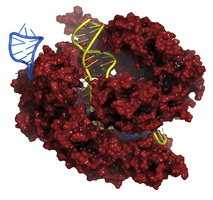
Chemist Creates Tool for Gene Editing
May 13, 2015| |
 Since 2013, scientists have used the gene editing tool CRISPR/Cas9, to excise a gene, alter its function, or introduce desired mutations. The method employs a bacterially derived protein (Cas9) and a synthetic guide RNA to induce a double-strand break at a specific location in the genome. The CRISPR (Clustered Regularly Interspaced Short Palindromic Repeats of DNA base sequences) method has shown tremendous promise to enable researchers to treat cystic fibrosis and sickle-cell anaemia, create laboratory animals that mimic human disease, and create a strain of wheat resistant to powdery mildew.
Since 2013, scientists have used the gene editing tool CRISPR/Cas9, to excise a gene, alter its function, or introduce desired mutations. The method employs a bacterially derived protein (Cas9) and a synthetic guide RNA to induce a double-strand break at a specific location in the genome. The CRISPR (Clustered Regularly Interspaced Short Palindromic Repeats of DNA base sequences) method has shown tremendous promise to enable researchers to treat cystic fibrosis and sickle-cell anaemia, create laboratory animals that mimic human disease, and create a strain of wheat resistant to powdery mildew.
Alexander Deiters, chemistry professor at the University of Pittsburgh, together with colleagues at the University of North Carolina at Chapel Hill, have found a lysine residue in Cas9 that can be replaced with a light-activated analog. The approach, developed by Deiters, generates a Cas9 protein that is functionally inactive, so called "caged," until the cage is removed through light exposure, activating the enzyme and thereby activating gene editing.
"This method may allow people to engineer genes in cells or animals with better spatial and temporal control than ever before," says Deiters. "Engineering a light switch into Cas9 provides a more precise editing tool. You can say, ‘In this cell, at this time point, is where I want to modify the genome.'"
More details about this research are available at the University of Pittsburgh website.
| |
Biotech Updates is a weekly newsletter of ISAAA, a not-for-profit organization. It is distributed for free to over 22,000 subscribers worldwide to inform them about the key developments in biosciences, especially in biotechnology. Your support will help us in our mission to feed the world with knowledge. You can help by donating as little as $10.
-
See more articles:
-
News from Around the World
- FAO Lauds G20 Efforts to Build Sustainable Food Systems
- PG Economics: GM Crops Continue to Provide Positive Impacts
- Kenyan Maize Farmers Express Support for GM Maize
- Plant Breeder Develops Rust-Resistant Soybean
- USDA Secretary Sees Difficult Talks on Trade between US and EU
- Chemist Creates Tool for Gene Editing
- Philippine Research Tackles Induction of Disease Resistance in Abaca
- Australian OGTR Authorizes Field Trials of Bt-HT Cotton
- Scientists Find New Specific Insecticide Target Protein
-
Research Highlights
- Plant Gene Required during High Temperatures Identified
-
Beyond Crop Biotech
- Transgenic Beef Cattle with High Beneficial Fatty Acid Developed
- PCC Develops New Technique for Screening Carabao Bull Fertility
-
Announcements
- Plant Breeding for Drought Tolerance Online Course
- BIO International Convention
-
Resources
- IFIC Releases New Video on Food Biotech Facts
-
Read the latest: - Biotech Updates (December 17, 2025)
- Gene Editing Supplement (December 17, 2025)
- Gene Drive Supplement (February 22, 2023)
-
Subscribe to BU: - Share
- Tweet
